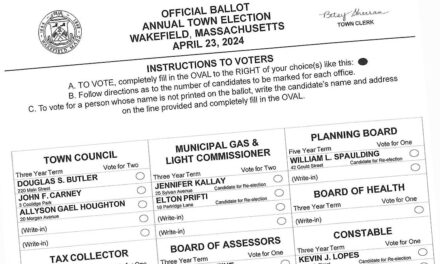By GAIL LOWE
MALDEN — The Department of Elementary and Secondary Education has announced that the state’s four-year graduation rate improved for the eighth consecutive year, with 86.1 percent of students who entered as ninth graders in 2010-2011 or who transferred into that same cohort at any time during high school — graduating within four years.
In Wakefield, high school Guidance Director AJ Beebe said that this year’s dropout rate showed a decrease over last year (0.7 percent vs. 0.8 percent).
In Wakefield, the graduation rate of 223 students was 92.8 percent. Another 3.1 percent received their GED (General Educational Development) diplomas, while 0.9 percent dropped out before graduation. Figures for surrounding districts were as follows:
• Lynnfield — Of 152 students, 95.4 percent graduated. 1.3 percent received GEDs, while 0.7 percent dropped out.
• Melrose — Of 233 students, 96.1 percent graduated. 1.3 percent received GEDs, while another 0.7 percent dropped out.
• North Reading — Of 197 students, 93.4 percent graduated. 0.5 percent received GEDs, while another 2.5 percent dropped out.
• Reading — Of 325 students, 94.2 graduated. 1.5 percent received GEDs, while another 1.5 percent dropped out.
• Stoneham — Of 190 students, 93.2 percent graduated. 0.5 percent received GEDs, while another 2.6 percent dropped out.
• Statewide — Of 73,168 students, 86.1 percent graduated. 1.2 percent received GEDs, while another 5.6 percent dropped out.
While graduation rates improved overall, some of the strongest increases were among African–American males, Hispanic students and students from low-income families – students who historically have had some of the lowest rates. The state’s annual dropout rate also declined to 2 percent in 2013–2014, the sixth consecutive year below 3 percent and the lowest overall rate in more than three decades.
“We have a tremendous opportunity to continue Massachusetts’ reputation as a global education leader,” said Gov. Charlie Baker, “and I am very proud of all of our educational professionals and students whose hard work is paying off. It is up to us to learn by their example to further improve our education system and to do all we can to ensure Massachusetts has the post-secondary education and career opportunities that allow our students to stay and be successful in the Commonwealth.”
“The remarkable progress we have seen since 2007 is a tribute to the teachers, counselors and administrators who are going the extra mile to identify, support and engage students who are at risk,” said Elementary and Secondary Education Commissioner Mitchell D. Chester. “In today’s world, where post-secondary education increasingly is a requirement for earning a livable wage, failing to earn a high school diploma robs students of a better future.”
According to the data released this year, 86.1 percent of the 73,168 students in the 2014 cohort graduated within four years, an increase of 1.1 percentage points from the 2013 cohort and an increase of 6.2 percentage points from 2006 cohort, when the Department of Elementary and Secondary Education first began calculating the cohort graduation rate. A cohort is comprised of students who entered high school as ninth graders or who transferred into the same cohort at any time during high school. The dropout reduction — from 3.8 percent (2006–07) to 2.0 percent (2013-2014) — resulted in about half as many students dropping out in 2013-2014 (5,746) as in 2006-07, when 11,436 students dropped out of school.
Fewer students dropped out in 2013-2014 than (502) in 2012-2013, and 5,690 fewer students dropped out than in 2006-2007, when the annual dropout rate was at a high mark of 3.8 percent.
In October 2009, when the state’s annual dropout rate was more than 3 percent, the Massachusetts Graduation and Dropout Prevention and Recovery Commission made a number of recommendations to dramatically reduce that rate. A number of those recommendations have been fulfilled, including expansion of what is now called the Early Warning Indicator System (EWIS) to make it available to all districts for grades 1 through 12 and reformed discipline laws to provide continued education for suspended and expelled students. The state, using federal High School Graduation Initiative funds, has also created a dropout prevention and recovery program, which was another of the commission’s recommendations.
Most major sub-groups improved their four-year graduation rates compared to the previous year. The largest gains were made by African-American males (+3.1 percentage points, from 67.7 percent for the 2013 cohort to 70.8 for the 2014 cohort), Hispanic students (+2.4 percentage points, from 66.8 to 69.2 percent) and students from low-income families (+2.5 percentage points, from 73.6 to 75.5 percent). Improvements for other major sub-groups were: Students with disabilities: +1.3, from 67.8 to 69.1 percent; limited English proficient students: +0.4, from 63.5 to 63.9 percent, African-American students overall: +1.1, from 73.8 to 74.9 percent; Asian students: +1.5, 90.6 to 92.1 percent; white students: +0.8, from 90.1 to 90.9 percent; female students: +0.9, from 88.1 to 89.0 percent; and male students: +1.3, from 82.1 to 83.4 percent.
In November 2010, the Commonwealth was awarded a five-year, $15 million federal grant through the federal High School Graduation Initiative to support statewide and local efforts for high school dropout prevention, intervention and recovery. The Massachusetts initiative, called MassGrad, has supported districts and schools with the highest dropout rates through a multifaceted approach that includes a Dropout Prevention and Recovery Work Group open to all districts, as well as start-up funding to support a range of innovative programming to best meet the needs of students most likely to dropout or to re-engage students who previously left school. That innovative programming has included graduation coaches, work and service-based learning opportunities, community coalitions, high school pathways such as the Gateway to College early college model, credit recovery options and social-emotional supports. The 2014-2015 school year is the final yeawr of federal funding for this initiative.
Over the past five years, the urban school districts that have made the largest gains in reducing the number of dropouts (2009-2010 and 2013-2014) included:
Boston had 342 fewer students drop out in 2013-14 than in 2009–10 (1.5 percentage point improvement, from 6.8 to 5.3 percent);
Springfield had 236 fewer students drop out in 2013-2014 than in 2009-2010 (3.3 percentage point improvement, from 10.5 to 7.2 percent)
Lawrence had 151 fewer students drop out in 2013-2014 than in 2009-2010 (4.8 percent point improvement, from 9.4 to 4.6 percent;
New Bedford had 106 fewer students drop out in 2013 than in 2009-2010 (2.9 percentage point improvement, from 8.1 to 5.2 percent); and
Worcester had 95 fewer students drop out in 2013-2014 than in 2009-2010 (1.4 percentage point improvement, from 3.8 to 2.4 percent).
Graduation rate data is online at www.doe.mass.edu/infoservices/reports/gradrates and https://profiles.doe.mass.edu/state_report/gradrates.asox. For more information, including other school and district numbers, look online at www.doe.mass.edu/infoservices/reports/dropout.




